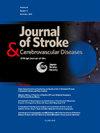Quantification of leptomeningeal collateral blood flow in hypertensive rats during ischemic stroke
IF 2
4区 医学
Q3 NEUROSCIENCES
Journal of Stroke & Cerebrovascular Diseases
Pub Date : 2025-02-01
DOI:10.1016/j.jstrokecerebrovasdis.2024.108195
引用次数: 0
Abstract
Objectives
There is increasing evidence that poor leptomeningeal collateral blood flow in hypertensive animals is due to increased vascular myogenic tone, indicating that therapies to enhance collateral blood flow during ischemic stroke may be particularly effective. To develop such therapies, we need a greater understanding of the factors that regulate collateral blood flow in the setting of hypertension. Therefore, we aimed to quantify blood flow velocity, diameter and absolute blood flow in individual collateral vessels in an ischemic stroke model in spontaneously hypertensive rats (SHRs) and determine which factors had the greatest influence on blood flow.
Materials and methods
We quantified collateral flow velocity and vessel diameter and calculated absolute collateral blood flow in SHRs (n = 5) during 70 min of middle cerebral artery occlusion (MCAO), using a fluorescent microsphere method.
Results
Average collateral blood flow significantly increased post-occlusion relative to baseline (pre-MCAO: 16.8 ± 7.1nL/min vs. post-MCAO: 146.4 ± 37.7nL/min, p = 0.02). Within animal linear regression analysis showed a strong positive correlation between changes in collateral blood flow versus changes in collateral diameter during stroke (r = 0.7–0.99, p = 0.3–0.002). In contrast, collateral blood flow was only weakly correlated with collateral blood flow velocity during stroke (r = −0.03–0.97, p = 0.9–0.1).
Conclusions
Collateral blood flow and velocity significantly increased post-occlusion. Collateral flow was strongly influenced by vessel diameter, likely because of marked baseline vasoconstriction of collaterals which is flow-limiting.
缺血性脑卒中期间高血压大鼠脑膜侧支血流的定量分析
目的:越来越多的证据表明,高血压动物的小脑膜侧支血流量不足是由于血管肌原性张力增加,这表明在缺血性卒中期间增强侧支血流量的治疗可能特别有效。为了开发这样的治疗方法,我们需要对高血压患者侧支血流量的调节因素有更深入的了解。因此,我们旨在量化自发性高血压大鼠(SHRs)缺血性卒中模型中单个侧支血管的血流速度、直径和绝对血流,并确定哪些因素对血流的影响最大。材料与方法:采用荧光微球法定量测定大脑中动脉闭塞(MCAO) 70 min时SHRs (n = 5)侧支血流速度和血管直径,计算绝对侧支血流。结果:闭塞后平均侧支血流量较基线显著增加(mcao前:16.75±7.1nL/min vs. mcao后:146.4±37.7nL/min, p=0.02)。动物线性回归分析显示卒中时侧支血流量变化与侧支直径变化呈正相关(r = 0.7-0.99,p = 0.3-0.002)。相比之下,卒中时侧支血流量与侧支血流速仅呈弱相关(r = -0.03-0.96,p=0.9-0.1)。结论:闭塞后侧支血流量和血流速度明显增加。侧枝血流受到血管直径的强烈影响,可能是因为侧枝明显的基线血管收缩,这是血流限制。
本文章由计算机程序翻译,如有差异,请以英文原文为准。
求助全文
约1分钟内获得全文
求助全文
来源期刊

Journal of Stroke & Cerebrovascular Diseases
Medicine-Surgery
CiteScore
5.00
自引率
4.00%
发文量
583
审稿时长
62 days
期刊介绍:
The Journal of Stroke & Cerebrovascular Diseases publishes original papers on basic and clinical science related to the fields of stroke and cerebrovascular diseases. The Journal also features review articles, controversies, methods and technical notes, selected case reports and other original articles of special nature. Its editorial mission is to focus on prevention and repair of cerebrovascular disease. Clinical papers emphasize medical and surgical aspects of stroke, clinical trials and design, epidemiology, stroke care delivery systems and outcomes, imaging sciences and rehabilitation of stroke. The Journal will be of special interest to specialists involved in caring for patients with cerebrovascular disease, including neurologists, neurosurgeons and cardiologists.
 求助内容:
求助内容: 应助结果提醒方式:
应助结果提醒方式:


